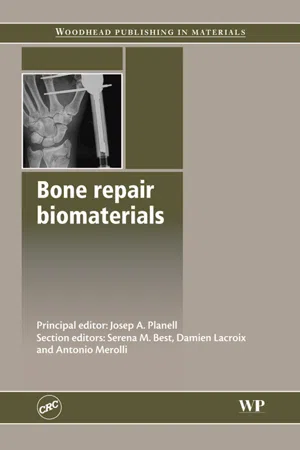1.2 Social and economical impact of musculoskeletal disease
Bone and joint degenerative and inflammatory problems affect millions of people across the world. In fact, musculoskeletal conditions, namely joint pathologies, fractures related to osteoporosis, back pain, serious injuries and different sorts of bone diseases and disabilities are among the most common causes of hundreds of millions of people worldwide suffering severe long-term pain and becoming physically handicapped or crippled.
It has been reported that over 100 million Europeans suffer chronic musculoskeletal pain, while in the USA musculoskeletal problems affect over 40 million people aged 45 years or older and are projected to affect more than 60 million persons, or 22% of the population, by the year 2030. While mortality from these conditions is low, they have a major effect on disability, medical costs and patient quality of life (Murray and Lopez, 1996; White and Harth, 1999).
The two most commonly reported causes of pain worldwide are back pain and arthritis. These two conditions represent a third of all reported causes. Low-back pain is the most common problem, affecting approximately 4–33% of the population. Although back pain affects almost everyone at some point in life, it seems to be more prevalent in men and in younger people. Arthritis, a pathology that involves damage to and inflammation of the joints, is the most frequent cause of pain in women and in older people. In fact, it has been estimated that osteoarthritis affects nearly 10% of men and 18% of women aged over 60 years, while rheumatoid arthritis, which is a more severe disease, affects 0.3–1% of the general population and is more prevalent among women and in developed countries (Elliott et al., 1999; Woolf and Pfleger, 2003). Moreover, it has been estimated that approximately 40% of arthritic adults suffer from osteoarthritis of the knee, 80% of people with osteoarthritis have limitation of movement and 25% cannot perform their major daily activities (Brooks, 2002).
Osteoporosis and, particularly, fractures caused by this illness are another of the most common problems affecting contemporary society. Osteoporosis has been defined as a condition in which BMD (bone mass density) is 2.5 standard deviations or more below the mean seen in young healthy subjects (WHO, 1994). Osteoporotic fractures primarily result from low BMD. However, microstructural changes in bone, especially of trabecular bone, also contribute significantly by increasing trabecular brittleness. This fragility is translated in an increase of vertebra, wrist and hip fractures (Kanis and Melton, 1994; Bonjour et al., 1996).
The prevalence of osteoporosis in the USA only is estimated to increase from ten million to more than 14 million people by 2020. This is a significant increase in population with a high risk of falls and fractures (National Osteoporosis Foundation, 2002). Indeed, fractures related to osteoporosis have almost doubled in number in the last decade and it is foreseen that 40% of all women over 50 years will suffer from an osteoporotic fracture (Bone and Joint Decade’s Musculoskeletal Portal, 2001). Although osteoporosis is less prevalent in men than in women, it is estimated that 30% of all hip fractures occur in men (Campion and Maricic, 2003). In addition, studies have shown that the fracture-related morbidity rate is higher in men than in women (Olszynski et al., 2004). As in the case of arthritis and other musculoskeletal diseases, osteoporosis is a functional abnormality and an important clinical syndrome leading to many problems with respect to quality of life (Yilmaz et al., 2008).
Hip and vertebral fractures are the most common fractures among individuals suffering osteoporosis. In osteoporotic women, low BMD particularly at the femoral neck, increases the risk of hip fractures two- to-threefold (Cummings et al., 1985).
Hip fractures constitute a major and growing health care problem in the Western world and an emerging problem in the developing countries (Cummings et al., 1985; WHO, 1994). It has been estimated that the worldwide annual number of hip fractures in 1990 was 1.66 million (Cooper et al., 1992b). If current demographic and incidence trends continue, the worldwide annual number of hip fractures will increase to 6.26 million by year 2050 (Cooper et al., 1992b; Melton, 1993). They are associated with considerable disability, loss of independence and diminished quality of life, but more importantly with a 20% reduction in expected survival (Cummings et al., 1990; Kannus et al., 1996; Melton, 1993; Richmond et al., 2003). Additionally, hip fractures constitute a significant economic burden for modern medical care, both directly during fracture treatment and indirectly particularly during the first year after the fracture (Lauritzen, 1996; Sernbo and Johnell, 1993). Thus, as measured by their frequency, influence on quality of life and economic cost, hip fractures are a public health problem of crisis proportions.
Vertebral fractures and deformities affect approximately 20% of postmenopausal women and are the hallmark of osteoporosis (O’Neill et al., 1996; Fechtenbaum et al., 2005). Postmenopausal women with previous or incident vertebral fractures are at higher risk of both vertebral and non-vertebral fractures than women without previous vertebral fractures, independent of bone density (Klotzbuecher et al., 2000; Kotowicz et al., 1994; Burger et al., 1994). In contrast t...
